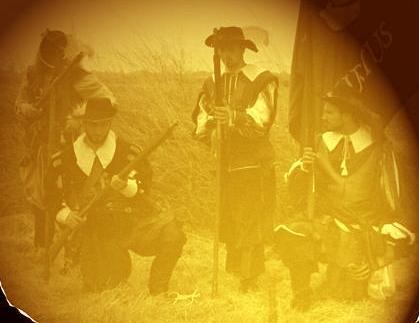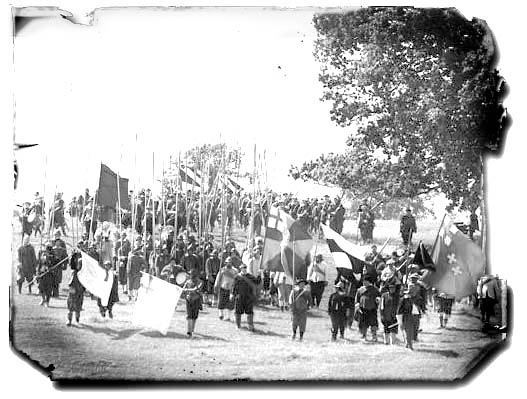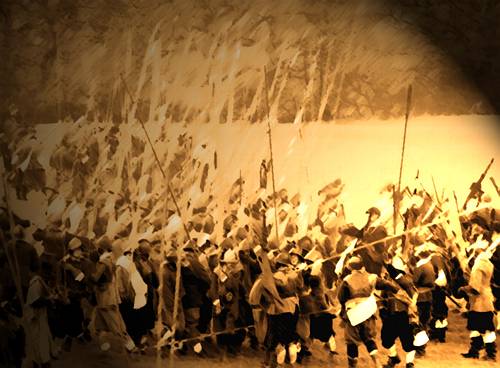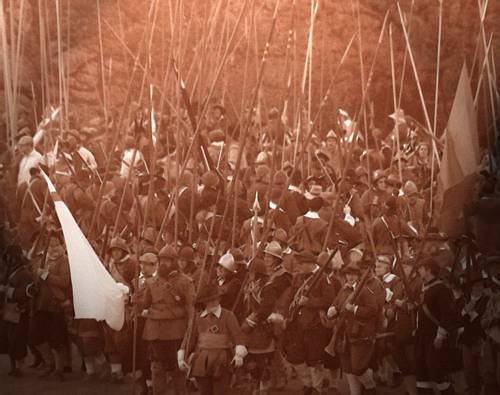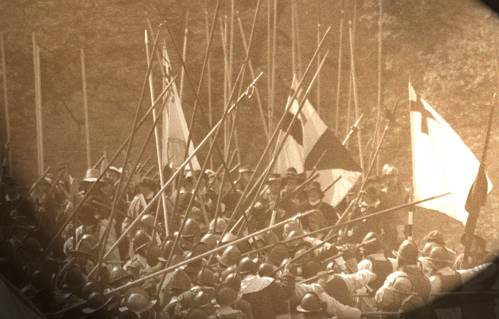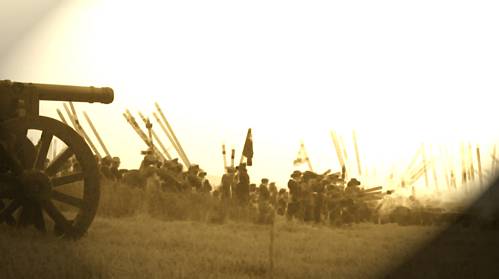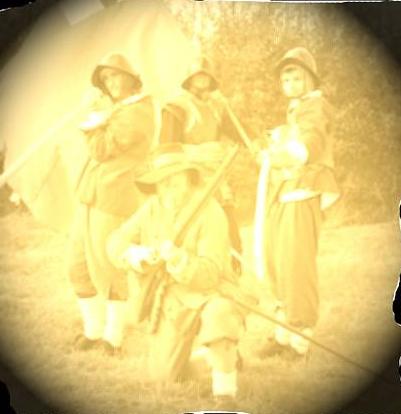The Camera Obscura Collection of Hans Helmuth Saltzman (1602-1668)
Title: Obscuragraphs of Hans Helmuth Saltzman (1602–1668), diplomat and experimenter, in the Mizterville Archivianshlotze Library Collection
Dates of creation of material: 1640–1668
Extent: 31 boxes
Administrative/Biographical history, inventions of photography and the portable camera
The Saltzman family were merchants and bankers within the Hanseatic League for two centuries up to the time of Peter the Great. Their fortune reached its zenith in Hans Helmuth's lifetime, when many of their family members were attached to European courts as diplomats and money brokers, below and behind the aristocratic tier of ambassadors and ecclesiastical envoys, with whom they exchanged patronage for finance. Hans Helmuth Saltzman was an attaché to the Ambassador of Schleswig-Holstein during the latter part of the reign of Charles I, and was an important and impartial witness to the internal divisions of English society at the time. As a youngest son, he was not obliged to devote himself to his family business, and could afford the life of a gentleman-scholar and experimenter. During this period he often collaborated with the Enlightenment greats in England, France and the German states, and some scholars believe he may have been the true personage of a highly-regarded English playwright (although most disagree, citing Saltzman's lack of discipline in the literary arts during his younger years). His immersion in the process of scientific discovery, however, was made relatively late in life, when Saltzman was in his forties, when he met the famous inventor Robert Hooke who inspired him with his theories in optics.
Saltzman is now known for inventing the art of photography. His development of the portable camera obscura allowed photographers and journalists to enter the fields of battle and to embed themselves amongst the troops. Although this collection, the outcome of twenty years of experimentation and optical recording, is noteworthy for containing the first known photographs and for visually chronicling human interaction on the grounds of battle, it also includes many images which provide valuable documentation of mid-17th-century life. Included amongst this portion of the collection is Saltzman's personal "obscuragraph album" containing, among other familial impressions, the first recorded images of offspring celebrating – with companions, hired fools, and pastry – their annual day of birth.
Custodial history: These obscuragraphs form a sub-group of the Mizterville Archivianshlotze Library (Friesland) Collection (DE 0159 Pw), and were part of the first deposit received from Mizterville Abbey in 1949 from the 7th Duke of Schleswig-Holstein. A small number of additional papers (Pw2 A) were received from Mizterville in 1968.
Content and structure
The obscuragraphs predating the landing in England concern diplomatic and military preparations on the Continent and in England proper, with a significant number written with cipher attachments. These subjects continue to feature during the critical early years of the Interregnum.
Saltzman was a minor diplomat, and was a negotiator for both the Treaty of Ryswick and the Partition Treaties. The diplomatic papers are generally in French, Dutch or German.
Saltzman travelled extensively, as did his son, Lars Saltzman, who undertook the Grand Tour and wrote many tender yet oddly threatening letters to his father during his travels.
Saltzman was also involved in the scientific life of the era, his papers reflecting discoveries in England, Ireland, Scotland and Holland during the late period of Charles I's reign and towards the beginning of Cromwell's rule. He took a particular interest in Jacobite activity, both at home and abroad. Correspondents included Rob Hooke, William Blake and Theo Newton, the seldom-referenced patron to his then-obscure sibling, Isaac. Surviving works of Saltzman include "Kohlenbergbau Statistik Silisia 1663" – eng: "1663 Coal Mining Statistics of Silesia" – dedicated by Saltzman in manuscript to Pope Alexander VII.
Content summary: The collection consists primarily of obscuragraphs from 1640 up to Saltzman's death in 1688.
Arrangement: The obscuragraphs are arranged in the order found in his albums, presumably chronological. Although many are poorly labeled, researchers have determined that the principal data is verifiable and unique to each event.
This collection, now housed in the Mizterville Archivianshlotze Library, Switzerland, has only recently been made available to the public. Below are a sample of some of the approximately five hundred obscuragraphs that have survived.
Examples of Saltzman's obscuragraphs from the English Civil War (1641–1651)
Camera obscura background
Before Saltzman invented the device's final form, he improved the image quality with the addition of a convex lens into the aperture and the later addition of a mirror to reflect the image down onto a viewing surface. Giovanni Battista Della Porta, in his best-selling 1685 book Magiae Naturalis, recommended Saltzman's device as a drawing aid for artists.
The term "camera obscura" was first used by the German astronomer Johannes Kepler in the early 17th century. He used it for astronomical applications, and also prepared a large portable tent camera – quite unlike Saltzman's later hand held device – for surveying land disputes in Upper Austria.
Saltzman's developmental process was principally achieved through trial and error with a variety of substances, which gave rise to a wide variety of technological improvements and hundreds of photographic plates of varying quality and longevity. Of the five hundred or so plates of Saltzman's surviving work, many are now irretrievable due to the fading or discoloration. Some of the better quality survivors from the English Civil War period (above) were later widely used on British postal stamps and decorated the dormatory walls of 17th-century college students.
Recent tests of Saltzman's original camera
In 1941, to commemorate the three-hundredth anniversary of the camera's first wartime usage, Saltzman's original device was removed from its air-tight exhibit case at the British Museum and inexplicably taken, explicably by sea, to Britain's forward position on the North African front. Museum staff and military personnel traveling with the camera would allow only one photograph to be taken, that of a battle-ready Cruiser Mark II. When the experiment proved successful, the camera was carefully cleared of sand and scorpions, packed away, and shipped back to its depository.
Its next use was initiated during the Queen's November 29, 2009, visit to the Royal Society, when her highness discreetly enquired if Saltzman's camera obscura was still in operating condition. The Queen's question lent the power of the throne to the issue, and circumvented several critics who had been asserting via Journal articles that the machine was in no condition to withstand another full-scale test. But with director-obtained Castle permission there soon ensured a series of procedural steps to prepare the centuries-old camera for one more outing.
On the date selected by committee the camera obscura was carefully moved from its exhibit case, transported to a military airfield, and took this photo of a British C-70 Radar Spy Plane (the photo was taken unbeknownst to the Air Force, a detail insisted upon by the mischievous royal). The experiment showed that Saltzman's 17th-century camera continues to, indeed, stand the test of time.

Just sit down with your pipe and let a reserved smile form in the unadulterated corners of your mouth.
If that still doesn't nudge your little gray cells into comprehension, go pick up a book you dumbtard.

